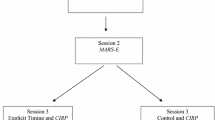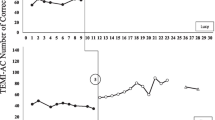Abstract
The primary purpose of intensifying interventions is to increase the effect of the intervention currently being delivered. However, there has been little empirical work completed that can provide guidance on selecting intensification methods. Because intensity can be modified in a number of ways that may differentially impact the time, effort, or resources required to deliver an intervention, it is important that systematic research is conducted that will assist practitioners in determining what methods serve to amplify intervention effects. This study evaluated the effect of the immediate delivery of accuracy feedback, as a method of intensification, when added to an explicit timing (ET) intervention. Results indicated that the addition of immediate accuracy feedback enhanced the effect of an ET intervention. Implications for these results and future research are provided.

Similar content being viewed by others
References
Barnett, D. W., Daly, E. J., Jones, K. M., & Lentz, F. E. (2004). Response to intervention: Empirically based special service decisions from single-case designs of increasing and decreasing intensity. The Journal of Special Education, 38, 66–79.
Chong, S. K., & Siegel, L. S. (2008). Stability of computational deficits in math learning disability from second through fifth grades. Developmental Neuropsychology, 33, 300–317.
Codding, R. S., Baglici, S., Gottesman, D., Johnson, M., Kert, A., & Lebeouf, P. (2009). Selecting intervention strategies: Using brief experimental analysis for mathematics problems. Journal of Applied School Psychology, 25, 146–168.
Codding, R. S., Lewandowski, L., & Eckert, T. (2005). Examining the efficacy of performance feedback and goal-setting interventions in children with ADHD: A comparison of two methods of goal setting. Journal of Evidence-Based Practices for Schools, 6, 42–58.
Codding, R. S., Shiyko, M., Russo, M., Birch, S., Fanning, E., & Jaspen, D. (2007). Comparing mathematics interventions: Does initial level of fluency predict intervention effectiveness? Journal of School Psychology, 45, 603–617.
Daly, E. J, I. I. I., Martens, B. K., Barnett, D., Witt, J. C., & Olson, S. C. (2007). Varying intervention delivery in response to intervention: Confronting and resolving challenges with measurement, instruction, and intensity. School Psychology Review, 36, 562–581.
Daly, E. J, I. I. I., Martens, B. K., Dool, E. J., & Hintze, J. M. (1998). Using brief functional analysis to select interventions for oral reading. Journal of Behavioral Education, 8, 203–218.
Daly, E. J., Martens, B. K., Hamler, K. R., Dool, E. J., & Eckert, T. L. (1999). A brief experimental analysis for identifying instructional components needed to improve oral reading fluency. Journal of Applied Behavior Analysis, 32, 83–94.
Duhon, G. J., House, S. H., & Stinnett, T. A. (2012a). Evaluating the generalization of math fact fluency gains across paper and computer performance modalities. Journal of School Psychology, 50, 335–345.
Duhon, G. J., Mesmer, E. M., Atkins, M. E., Greguson, L. A., & Olinger, E. S. (2009). Quantifying intervention intensity: A systematic approach to evaluating student response to increasing intervention frequency. Journal of Behavioral Education, 18, 101–118.
Duhon, G., Poncy, B. C., Hubbard, M., Purdum, M., & Kubina, R. (2012). An examination of various intervention components with explicit timing procedures to increase math fact fluency. Symposium at the meeting of the Association of Behavior Analysis, Seattle, WA.
Eckert, T. L., Lovett, B. J., Rosenthal, B. D., Jiao, J., Ricci, L. J., & Truckenmiller, A. J. (2006). Class-wide instructional feedback: Improving children’s academic skill development. In S. V. Randall (Ed.), Learning disabilities: New research (pp. 167–185). Hauppauge, NY: Nova Science Publishers.
Figarola, P. M., Gunter, P. L., Reffel, J. M., Worth, S. R., Hummel, J., & Gerber, B. L. (2008). Effects of self-graphing and goal setting on the math fact fluency of students with disabilities. Behavior Analysis in Practice, 1, 36–41.
Filter, K. J., & Horner, R. H. (2009). Function-based academic interventions for problem behavior. Education & Treatment of Children, 32, 1–20.
Forman, S. G., Shapiro, E. S., Codding, R. S., Gonzales, J. E., Reddy, L. A., Rosenfield, S. A., et al. (2013). Implementation science and school psychology. School Psychology Quarterly, 28(2), 77–100.
Freeland, J. T., & Noell, G. H. (1999). Maintaining accurate math responses in elementary school students: The effects of delayed intermittent reinforcement and programming common stimuli. Journal of Applied Behavior Analysis, 32, 211–215.
Gettinger, M. (1995). Best practices for increasing academic learning time. In A. Thomas & J. Grimes (Eds.), Best practices in school psychology III (pp. 343–354). Washington, DC: National Association of School Psychologists.
Gross, T. J., & Duhon, G. J. (2013). Evaluation of computer-assisted instruction for math accuracy intervention. Journal of Applied School Psychology, 29, 246–261.
Harding, J., Wacker, D. P., Cooper, L. J., Millard, T., & Jensen-Kovalan, P. (1994). Brief hierarchical assessment of potential treatment components with children in an outpatient clinic. Journal of Applied Behavior Analysis, 27, 291–300.
Harn, B. A., Linan-Thompson, S., & Roberts, G. (2008). Intensifying instruction: Does additional instructional timemake a difference for the most at-risk first graders? Journal of Learning Disabilities, 41, 115–125.
Holland, J. G. (1960). Teaching machines: An application of principles from the laboratory. Journal of the Experimental Analysis of Behavior, 3, 275–287.
House, S. E., & Duhon, G. J. (in press). Using brief experimental analysis to determine generalization strategies. Journal of Behavioral Education.
Lovett, B. J., & Eckert, T. L. (2009). Reinforcement sensitivity and responsiveness to performance feedback: a preliminary investigation. Journal of Applied School Psychology, 25, 204–219.
Macmann, G. M., Barnett, D. W., Allen, S. J., Bramlett, R. K., Hall, J. D., & Ehrhardt, K. E. (1996). Problem solving and intervention design: Guidelines for the evaluation of technical adequacy. School Psychology Quarterly, 11, 137–148.
National Assessment of Educational Progress. (2009). National Assessment of Educational Progress Mathematics assessment. U.S. Department of Education, Institute of Education Sciences, National Center for Education Statistics, Washington, DC.
Noell, G. H., Gresham, F. M., & Gansle, K. A. (2002). Does treatment integrity matter? A preliminary investigation instructional implementation and mathematics performance. Journal of Behavioral Education, 11, 51–67.
Poncy, B. C., Duhon, G. J., Lee, S. B., & Key, A. (2010). Evaluation of techniques to promote generalization with basic math fact skills. Journal of Behavioral Education, 19, 76–92.
Poncy, B. C., Skinner, C. H., & Jaspers, K. E. (2007). Evaluating and comparing interventions designed to enhance math fact accuracy and fluency: Cover copy, and compare versus taped problems. Journal of Behavioral Education, 16, 27–37.
Rhymer, K. N., Dittmer, K. I., Skinner, C. H., & Jackson, B. (2000). Effectiveness of a multi-component treatment for improving mathematics fluency. School Psychology Quarterly, 15, 40–51.
Rhymer, K. N., Henington, C., Skinner, C. H., & Looby, E. J. (1999). The effects of explicit timing on mathematics performance in Caucasian and African American second-grade students. School Psychology Quarterly, 14, 397–407.
Rhymer, K. N., & Morgan, S. K. (2005). Comparison of the explicit timing and interpersal interventions: Analysis of problem completion rates, student preference, and teacher acceptability. Journal of Behavioral Education, 14, 283–303.
Rhymer, K. N., Skinner, C. H., Hennington, C., D’Reauz, R. A., & Sims, S. (1998). Effects of explicit timing on mathematics problem completion rates in African-American third-grade elementary students. Journal of Applied Behavior Analysis, 31, 673–677.
Shapiro, E. S. (2011). Academic skills problems: Direct assessment and intervention (4th ed.). NY: Guilford Press.
Skinner, B. F. (1968). The technology of teaching. New York: Appleton-Century-Crofts.
Skinner, C. H., Turco, T. L., Beatty, K., & Rasavage, C. (1989). Cover, copy, and compare: A method for increasing multiplication fluency in behavior disordered children. School Psychology Review, 18, 412–420.
Van Houten, R. (1984). Setting up performance feedback systems in the classroom. In W. L. Heward, T. E. Heron, J. Trap-Porter, & D. S. Hilt (Eds.), Focus upon applied behavior analysis in education (pp. 112–125). Columbus, OH: Merrill.
Van Houten, R., Morrison, E., Jarvis, R., & McDonald, M. (1974). The effects of explicit timing and feedback on compositional response rate in elementary school children. Journal of Applied Behavior Analysis, 7, 547–555.
Van Houten, R., & Thompson, C. (1976). The effects of explicit timing on math performance. Journal of Applied Behavior Analysis, 9, 227–230.
Vaughn, S., Linan-Thompson, S., Kouzekanani, K., Bryant, D. P., Dickson, S., & Blozis, S. A. (2003). Reading instruction grouping for students with reading difficulties. Remedial and Special Education, 24, 301–315.
Woodward, J. (2006). Developing automaticity in basic multiplication facts: Integrating strategy instruction with time practice drills. Learning Disability Quarterly, 29, 269–289.
Author information
Authors and Affiliations
Corresponding author
Rights and permissions
About this article
Cite this article
Duhon, G.J., House, S., Hastings, K. et al. Adding Immediate Feedback to Explicit Timing: An Option for Enhancing Treatment Intensity to Improve Mathematics Fluency. J Behav Educ 24, 74–87 (2015). https://doi.org/10.1007/s10864-014-9203-y
Published:
Issue Date:
DOI: https://doi.org/10.1007/s10864-014-9203-y




